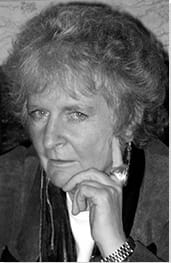Summary of Maggi Hambling
One of England's greatest living artists, Hambling earned her formidable reputation on the back of a series of vivid portraits; sublime land and seascapes; and for three highly unconventional (and highly controversial) memorial sculptures. Her body of work also reveals an unflinching fascination with death (realized expressly in respect of those who were once close to her). Hambling nurtured her public persona as a feisty and acerbic "queer icon" who (before the setback of a near-fatal heart attack) brazenly exalted the "virtues" of smoking and drinking extra-strength beer. Latterly, the focus of Hambling's art has reflected her impassioned standpoint on environmental matters, and her deep concern for the long-term wellbeing of the planet.
Accomplishments
- Hambling's paintings of her home county of Suffolk (on England's east coast), have seen her extend the proud tradition of English land and seascape painting, as exemplified by some of the nation's greatest artists, Thomas Gainsborough, J.M.W. Turner, and John Constable. Her dramatic paintings of waves, meanwhile, have drawn many favorable comparisons with the legendary Japanese ukiyo-e artist, Katsushika Hokusai.
- Hambling's highly idiosyncratic statutes of gay and feminist torchbearers Oscar Wilde and Mary Wollstonecraft (respectively), and her monument (a fractured scallop shell) to English composer and conductor Benjamin Britten, have sharply divided opinion. But there can be little doubt that the discussions these pieces have generated have helped animate the achievements of the pioneering cultural figures they honor.
- Hambling's attraction to the theme of death first revealed itself through her My mother dead drawings. These pieces led to a number of further "coffin" portraits featuring her father, close friends, and her lover. Expressing her admiration for the celebratory attitude towards death that is such a strong feature of Mexican art and culture (and epitomized by its annual "Day of the Dead" ("Día de los Muertos") celebrations), Hambling has stated that she had found it "rather therapeutic to go on painting them [her loved ones] after death".
- Hambling's unbreakable connection with her Suffolk roots has played a lasting role in the artist's personal mythology. Indeed, having spent six weeks in a New York hospital following her near-fatal brush with heart disease and COVID, Hambling headed straight for the place "where it all began" (as she put it) to create her ferocious, semi-abstract, Maelstrom series of seascapes.
The Life of Maggi Hambling
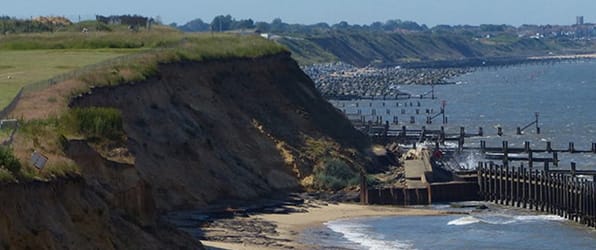
New York's Marlborough Gallery states that "Maggi Hambling has been a prominent and controversial figure in the United Kingdom for over fifty years [...] Embracing the social and political situations in which her paintings are produced, and the vacillations between figurative and abstract readings, [her] paintings rhetorically perform as figures of speech".
Important Art by Maggi Hambling
My Mother Dead, VII
Hambling earned the nickname "Maggi 'Coffin' Hambling" (from her friend, British jazz musician and art critic, George Melly) after the artist had produced a number of postmortem portraits, including My Mother Dead, VII. Her "coffin portraits" have featured her mother, her father, her lover, Henrietta Moraes, mentors Arthur Lett-Haines and Cedric Morris, and her friend, the artist and filmmaker, Derek Jarman. "I find it rather therapeutic to go on painting them after death", she once said, "[it's] a way of coming to terms with their death". Arts writer Sean Burns says of My Mother Dead VII that it "is a delicate, frank observational drawing of precisely that: a portrait of Marjorie Hambling's last moments, her eyes closed, her expression calm. The areas of her face emerge from a series of repetitive steaks of graphite, and her likeness to Maggi is uncanny".
Hambling said (with typical candor), "People are surprised that I've drawn people in their coffins, but it seems quite obvious to me. It's the last time you see them. She'd [her mother] been quite ill towards the end of her life, so she had a sort of serenity about her. And also, whenever she'd posed for me previously, when I'd gone home for the weekend and started drawing her in my sketchbook, she'd sort of arrange her hair, and then she'd take her spectacles off, and then she'd say, 'Have you finished?' Hopeless. So I did sort of say, 'I've got you now, Mother. You're not going anywhere this time'".
Hambling has also expressed her admiration of the Mexican attitude towards death. She said, "It's there [in Mexican culture] like the flip side of the coin, life and death together. Death not constantly shuffled out of sight as it is in England". Hambling has even painted herself as a skeleton. Her, Self-Portrait (2021), alludes to the Mexican custom of Día de los Muertos (day of the dead) and the iconic skeletal grande-dame, Calavera Catrina (first drawn around 1910-12 by Mexican illustrator and lithographer José Guadalupe Posada). Writes Burns, "Self Portrait (2021) is a smiling, almost quivering skull atop the loosely executed figure in a coffin. It could be horrifying, but there's a camp humour to its frankness. After six decades of artmaking, in which Hambling has painted dead and dying friends and loved ones, she is reckoning with her own mortality. Above the coffin, a cloud rises towards the top of the canvas; look closely, and you can see the shadow of Hambling's eye sockets and the outline of her distinctive hair - evaporating".
Graphite on paper - The British Museum, London
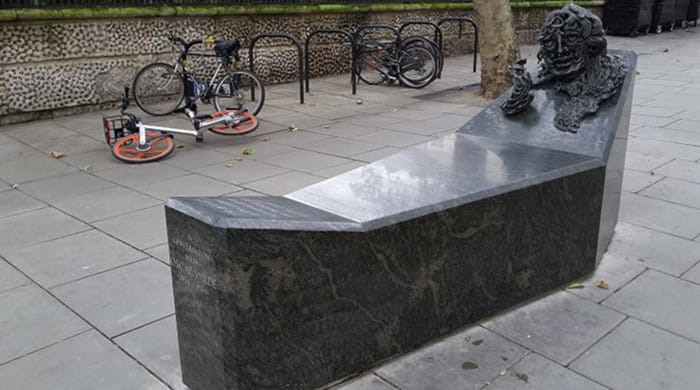
A Conversation with Oscar Wilde
The creation of a permanent memorial to Wilde in central London was first suggested during the late 1980s/early 1990s by fans of the playwright, notably Hambling's close friend, the Queer avant-garde filmmaker, Derek Jarman. Following Jarman's untimely death in 1994, a committee, including thespians Dame Judi Dench, Sir Ian McKellen, and the Irish poet and Nobel Laurette, Seamus Heaney, brough the proposal to fruition with hundreds of individual donors and foundations contributing funds towards the project. Following Danny Osbourne's Oscar Wilde Memorial Sculpture, which was unveiled in Wilde's birthplace (in Merrion Square, Dublin) a year earlier, Hambling's work was chosen from a shortlist of six. She said of her work, "The idea is that he is rising, talking, laughing, smoking from this sarcophagus and the passer by, should he or she choose to, can sit on the sarcophagus and have a conversation with him". The sculpture itself resembles a coffin-shaped bench (made of green granite) from which a bronze portrait bust of Wilde's laughing head emerges next to a bronze hand holding a cigarette. The bottom end of the coffin carries an inscription of Hamblin's favorite Wilde quote (taken from his play, Lady Windermere's Fan): "We are all in the gutter but some of us are looking at the stars".
The memorial, while popular with passers-by, met with mixed reviews amongst art critics. Tom Lubbock, chief art critic for The Independent, acknowledged the need for a Wilde memorial in London and commended the project for its "real and proper Victorian public spirit", but he dismissed the sculpture itself, likening it to a Madame Tussauds waxwork. He wrote: "We have nothing of the nerve, the folly, the ruin, the glory [of Wilde]. We have nothing for history - only the whimsical notion of us chatting cheerfully with this anodyne figment". Meanwhile, anti-smoking campaigners criticized the work for promoting smoking. In fact, Wilde's cigarette has been stolen/removed so many times that it has been dubbed "the most frequent act of vandalism/veneration to a public statue in London" (and is no longer replaced). It was left to committee member Jeremy Isaacs to make the case that Hambling's sculpture "evokes more favorable response from the public than any other statue I know in London, with the possible exception of Peter Pan".
Green granite and bronze - Charing Cross, London, England
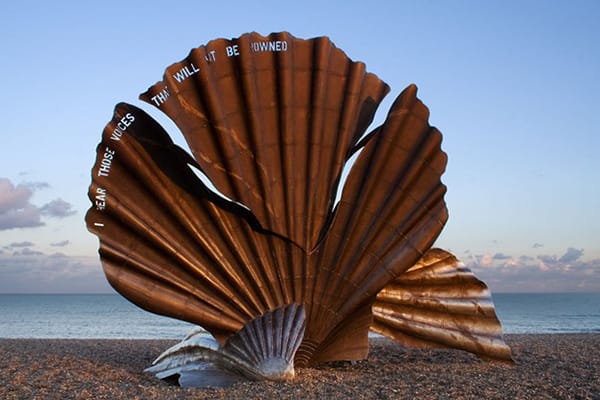
Scallop (Memorial to Benjamin Britten)
Hambling's second major monument commission, Scallop, is dedicated to British composer and conductor Benjamin Britten. It sits in the picturesque setting of the Aldeburgh Beach, Suffolk, which is close to Britten's homes. The four-meter-high cast stainless steel sculpture takes the form of two halves of a fractured scallop shell. The top edge of the upright shell is engraved with a quotation from Britten's 1945 opera, Peter Grimes: "I hear those voices that will not be drowned". The other half of the shell lies prone, creating a platform on which visitors can sit. Culture writer Lydia Figes notes that "Besides Britten, Hambling was inspired by the nostalgic memory of being a child [she, too, grew up on the Suffolk coast] and holding a shell to one's ear to hear the sea". Hambling herself has explained that "An important part of my concept is that at the centre of the sculpture, where the sound of the waves and the winds are focused, a visitor may sit and contemplate the mysterious power of the sea".
As with her earlier monument to Oscar Wilde, Scallop split opinion. Some locals called it "a monstrosity" and "a bloody awful-looking thing". Hambling was hurt and upset by these reactions because, in her words, "I thought it was one of the more beautiful things I've ever managed to make". Many local residents complained that the structure clutters up the view of an otherwise pristine section of the beach, and that it also attracts vandals. As Hambling designed and paid for the work (rather than it being a public commission), the public felt that she hadn't taken into account the opinions of local residents in the planning process. Responding to this criticism, Hambling commented, "It never crossed my mind that it would be in any way controversial. I thought that people might come up and say thank you - more fool me. My own newsagent just said to me, 'Hello, how's the eyesore coming along?'".
A local committee had even petitioned to have Scallop removed, while Hambling insisting that it was made "for that particular place in juxtaposition with the sea, and that is where I want it to stay". Despite the local objections, Scallop remains a favorite of English author Susan Hill, who was a friend of Britten's and visits the beach often. Hill defend the sculpture as a "glorious thing of power and beauty". Overcoming its distractors, Scallop won the 2006 Marsh Award for Excellence in Public Sculpture.
Stainless steel - Aldeburgh beach, Suffolk, England
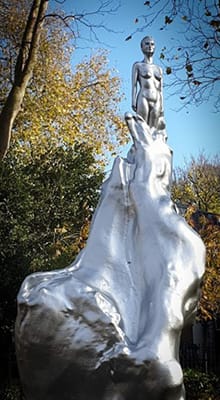
A Sculpture for Mary Wollstonecraft
The third of Hambling's trio of provocative public monuments is dedicated to "the mother of feminism" (Mary Wollstonecraft). Affectionately dubbed the "patron saint of loudmouthed women" (by the New Yorker's art critic Anna Russell) she lived during the late eighteenth century and emerged as an influential British proto-feminist writer and philosopher, founded a "School for Girls" (in 1784), and penned works such as the seminal, A Vindication of the Rights of Woman (1792). Over two centuries after her passing, a committee was formed with the aim of erecting a sculpture in Wollstonecraft's honor in Newington Green (near Wollstonecraft's home, and now often referred to as "the birthplace of feminism"). The committee members voted unanimously for Hambling's design which featured Wollstonecraft's quote: "I do not wish women to have power over men but over themselves". Her design, which has the quotation inscribed on the work's base, features a diminutive, naked and nondescript "everywoman" rising out of an irregular, organically-shaped plinth within which other body parts can be identified. As Hambling explains, "The tower the figure rests upon refers to the struggle of women. They are mingling female forms".
Hambling faced fierce criticism for the monument, with feminist writer Caroline Criado Perez calling it "catastrophically wrong [...] I honestly feel that actually this representation is insulting to [Wollstonecraft]. I can't see her feeling happy to be represented by this naked, perfectly formed wet dream of a woman". Hambling's responded by saying that "clothes would have restricted her. Statues in historic costume look like they belong to history because of their clothes. It's crucial that she is 'now'" while adding that throughout history "There are plenty of schlongs [penises] honoring men in art". In fact, the plinth on which the figure stands clearly states that the sculpture was not intended as an historical likeness of Wollstonecraft. Says the artist, "[Critics] mistakenly thought it represented Wollstonecraft herself, but it's her spirit, she was a rebel, for goodness sake!". Hambling has also countered criticisms attacking the diminutive size of the female figure by stating that "Most male historic statues are way over life-size. My point was that the female figure doesn't need to dominate to be powerful".
Many local to Newington Green are in favor of the monument. A nearby cafe owner told The Guardian reporter Mark Brown "It has become a tourist attraction. Everyone, whatever gender they are, has an opinion on it and that's lovely. It's a buzz. Opinions might be polarized, but everybody is talking about Mary, people are discussing it while they are getting a coffee. Mary Wollstonecraft was a radical woman and I think she would have loved the stir it has caused". Historian Sophie Coulombeau concurs, saying that people "with a very strong opinion" on the statue might be led to read Wollstonecraft's work and discover that "she's a lot weirder and ickier and more surreal than most [people] realise". Says Hambling, the sculpture is like "a rocket of hope going up to the sky, tracking the fight for female empowerment Wollstonecraft started" and the figure at the top is one that has "evolved organically from, is supported by, and does not forget, all her predecessors".
Bronze and granite - Newington Green, England
Edge XIX
Hambling says that the paintings in her Edge series (which she began in 2014) "come from a feeling of fury [...] about the fact that we are destroying the planet". These abstracted works, which bear the influence of Asian art, and particularly, the great Japanese ukiyo-e artist, Hokusai Katsushika, are dominated by swirls, drips, and splotches of blue, white, and gray. In Edge XIX, Hambling alludes to the melting of the polar ice caps, while other works in the series contain the figures of lone polar bears (a blatant emotional reminder of the impact of climate change).
The text accompanying the exhibition of the Edge series at London's Marlborough Gallery, in Spring 2017, announced that the works "succeed in convincing us that we are present at, and indeed become part of, their making. We are 'on the edge', confronted by the fragility of existence, both ours and that of the planet. The artist has never been afraid of addressing big themes and delivers simultaneous presence of life and death in her work. In this new series, polar icecaps melt, a trafficker drifts, Aleppo and its inhabitants fall, ghosts hover and Hamlet questions. Human vulnerability is continually - and viscerally - expressed. We are asked not so much what do we think, but rather what do we feel". Meanwhile, art historian Jason Rosenfeld contends that Hambling's Edge paintings "impress through their communication of earth bursting close to sky in the forms of rising peaks. Like Monet's Nympheas, the best of these energetically painted pictures [...] operate in distance, depth, perspective, closeness, and the void simultaneously".
Oil on canvas
Maelstrom II
In March of 2022, Hambling suffered a heart attack (she thinks that she was rendered "technically dead" for a short time) and spent six weeks recovering in a New York hospital. Following this profound personal experience (and after which, as she puts it, "I was still feeling very odd") Hambling returned to the Suffolk coast where she produced a numbered series of paintings titled Maelstrom. Each work in the series, featured expressive strokes, splotches, and swirls of paint, dominated by colors of black, white, red, brown, and dark blue, applied expressively to her canvas. Although they offer no obvious figurative element, Hambling said of the works that they are "not abstract at all", inasmuch as it is for the viewer to see in the painting what they will, be it landscapes, faces, or perhaps something else entirely.
Arts journalist Victoria Woodcock describes the Maelstrom paintings as "dense and stormy compositions" and "swarming masses of energetic marks". Hambling explains that "they're about Ukraine [recently invaded by Russia], but also about what happened to me [adding] I think there's a freedom about them that possibly wasn't there before. And the feeling that there's less time makes them even more urgent". Frankie Rossi Art Projects in London, which exhibited the Maelstrom series in late 2022, writes that "The paintings manifest intense landscapes of experience - each is a portrait of where the heart and mind go when the body is compromised - a realm at once mysterious and challenging, sublime and intimate. [They] affirm, ultimately, what it means to be alive".
Oil on canvas
Biography of Maggi Hambling
Childhood
Margaret - "Maggi" J. Hambling was the youngest of three children born to Harry Smyth Leonard Hambling, a bank cashier and local politician (and a keen amateur painter), and Marjorie (née Harris) Hambling, a teacher of ballroom dancing. Hambling has described her childhood self as a "gang-leader and a clown", who became "obsessed" with Irish poet and playwright Oscar Wilde, and who "fell in love with my biology teacher". Of her early interest in art Hambling recalled, "when I was eight or nine, my mother brought me to [Thomas] Gainsborough's House [in Sudbury, Suffolk) and that's where I saw real painting for the first time [...] It's where I first registered a real oil painting; it was just fields and cows, but it just took me to this other place".
When she was 14, and much to her own astonishment, Hambling came top of her class in a school art exam. On the back of this early triumph, her mother paid for her daughter to take up a short residence with her art teacher, Yvonne Drewry. It was she who introduced Hambling to painting with oils. Drewry was also responsible for introducing her young protégé to the "joys of smoking". Hambling recalls, "I was painting in a field, and Yvonne came up to me. It was very hot, and insects were sticking to the painting and the brushes and everything. And she said, 'There's only one thing to do, and that's have a cigarette,' because it would drive away the insects. So I started to smoke at the age of 14, which [for me] became inseparable from oil painting".
Education and Early Training
The following year, Hambling submitted two of her landscapes to the nearby East Anglian School of Painting and Drawing (The Artists' House, as it was otherwise known, counted Lucian Freud amongst it alumni), founded in 1937 by British painters Cedric Morris and Arthur Lett-Haines. So impressed were they with her efforts, the two men invited Hambling to paint with them during her school holidays. Hambling recalled "the first day of the holidays I was there, but I was too nervous to go up to the house, so I sat in a ditch at the end of the drive and painted the ditch. Eventually I went in, and that's really where life began. Lett [...] said the most important thing that anyone's ever said to me about art. He said, 'If you're going to be an artist, you've got to make your work your best friend that you can go to whatever you're feeling - tired or bored or happy or sad or randy - and have a conversation with it.' And that's how I've lived my life. And he also said, 'There's no point in being an artist unless you have imagination.' I was very lucky at the age of 15 for these things to be said to me".
Hambling formally entered the East Anglian School of Painting and Drawing in 1960, where she continued to study under Morris and Lett Haines. She then attended the Ipswich School of Art between 1962-64, before moving to the Camberwell College of Arts in London (1964-67), and lastly, the Slade School of Fine Art at University College London, (1967-69). Hambling said, "When I got into Camberwell it was wonderful, because working, famous artists would come in to talk to us. So I worked consistently in the life room and then experimented with everything that was going on: abstract expressionism, pop art, op art and all those things. At the Slade I made conceptual art for a few years. I was quite political, and I didn't think any of the abstract painting being made at the top of the Slade had anything to do with real people and real life. [...] I did some street art too, and went on working conceptually for a few years. But I was always having to find someone who knew more about photography, someone who knew more about sound, and so on. So I was feeling like the impresario of the idea rather than the maker. And it did finally occur to me that the only thing I was going to make myself, with my hands, was a painting. So I returned to painting".
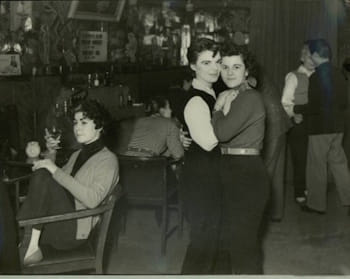
The New Yorker's art critic Anna Russell notes that when Hambling arrived in London, "she was almost nineteen, and still a virgin [...] but not for long. She became involved with a series of men and women, lived in a shared house dubbed the Queers Castle, and knocked about the Gateways Club, a legendary lesbian night club, where she claims she was once banned for suggestive dancing". Her circle of friends included artists David Hockney, Bridget Riley, Derek Jarman, and Francis Bacon, whose muse, Henrietta Moraes, became Hambling's lover ("she took me over completely", said Hambling). In 1969, Hambling received a grant to study in New York for a few months. During her trip, she attended the historic Woodstock Music Festival and a Nina Simone concert.
On her return to England, Hambling began drawing and painting strangers she encountered in pubs (referring to them as "good places in which to observe"). She also painted the arthritic hands of her neighbor, Frances Rose. Russell describes these pieces as "tender, slightly surreal paintings, with undercurrents of loneliness". Hambling was at Rose's bedside when she passed away, "It was the first time I had been present at someone's death and I couldn't get it out of my head", she said. The art critic Peter Fuller writes, "It was inevitable that an artist possessed of such considerable gifts would [...] return to drawing and painting. Her portrait heads of [the early 1970s] were reminiscent of those early pictures by David Hockney which contain traces of child art, combined with Francis Bacon's savage viewpoint". Fuller adds that her paintings of Rose had pointed her towards "the central concern of Hambling's maturity: the search for a way of painting 'fallen' modern men and women without resorting to the monstrous [as Bacon had]. Her paintings of the mid-1970s revealed a sympathy with human frailty and impoverishment, but they did not always escape a certain murkiness of color and handling".
Mature Period
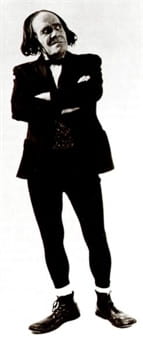
In 1980, Hambling became the first artist-in-residence at London's National Gallery (where she lined her studio with tin foil so she could smoke without detection). She has said that painting in the close vicinity of work by the likes of Rembrandt and Titian was a "formative experience", but it also left her feeling like "a performing monkey" (her first painting in residency was of a Gallery security guard). Hambling's best known works from this period were portraits of the cult comedian and actor, Max Wall. Fuller says of the Wall portraits (which were exhibited at the National Portrait Gallery in 1983), that they "combined a sense of the mundane - of the absurdity, sadness and vulnerability of human life - with vivid images of the transforming power of reverie, wit, illusion and imagination, suggested by the magical wreaths and whisps of cigarette smoke, like something from a genie's lamp, that appear again and again in these pictures".
In 1984 she became a "team leader" (for which she wore a bowtie and even, on occasion, a false moustache) on the network television quiz show, Gallery. With George Melly as anchor and question-master, Hambling and her team (of three) were tested on their knowledge of famous artists and their artworks. In 1985, the National Portrait Gallery commissioned her to paint the portrait of the Nobel Prize winning chemist, Professor Dorothy Hodgkin. It was around this time that Hambling met her "companion" ("I hate the word partner" she once said), Victoria "Tory" Dennistoun (the former wife of Lord, and former race jockey, John Lawrence Oaksey) after her marriage had ended "in unhappily public fashion".
Some of Hambling's most poignant portraits were produced during the late 1980s and the 1990s. Many of these were "therapeutic" postmortem portraits. Arts journalist Christina Ruiz comments, "From the beginning, [Hambling] has confronted death in her work, fearlessly sketching and painting those closest to her as they lay dying or dead: her early art teachers Arthur Lett-Haines and Cedric Morris; her mother and father; friends and lovers. [...] Her friend George Melly once told her she would go down in history as Maggi 'Coffin' Hambling". Russell adds, "[Hambling] describes a trip to Mexico, and her appreciation for what she perceives as the country's attitude toward death. 'It's there, like the flip side of the coin, life and death together,' she said. "Death not constantly shuffled out of sight as it is in England". Hambling complemented her portraits of this period with a series of landscapes and seascapes for which she received the Jerwood Painting Prize (for "excellence in painting") in 1995. She accepted an OBE (Order of the British Empire) for her contributions to the arts in the same year.
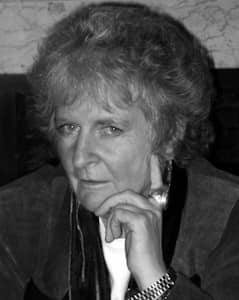
In 2004, Hambling's portrait of Michael Jackson was omitted from the Royal Academy's summer exhibition because she submitted the painting with a note protesting the singer's innocence against charges of child molestation. Hambling, who was proudly referring to herself as a "professional smoker", also refused to give television interviews if she was forbidden to smoke in the television studio (Russell noted that "For a long time, she had a rule that she could not be photographed without a cigarette and a scowl").
Hambling finally gave up her habit in 2004 (though continued to "vape"), but became actively involved in the campaign against the total ban on smoking in public places in England (which became law on July 1, 2007). She said, "Just because I gave up at 59, other people may choose not to. There must be freedom of choice, something that is fast disappearing in this so-called free country". (She found a kindred spirit in her friend and compatriot, Hockney, who said, "It is the relentlessness of these people that has demonized smoking in England and America. Why are they listened to? It wouldn't happen in France, Germany, Italy, or Spain". Hockney even moved his home to France because "you can smoke more freely there"). Her anger at the countries "draconian" anti-smoking rules notwithstanding, she gracefully accepted her CBE award in 2010.
Latter Hambling has become increasingly concerned with climate change which she has addressed through a series of animal paintings with titles such as The Last Baboon (2018), Rhino Without Horn (2019), and Baby Elephant Abandoned (2019). Arts writer Belle Hutton writes, "In one painting, Caged, 2019, a bird frantically attempts to fly from its metal home. A painting like that makes for poignant viewing: we feel for the captive bird and its relentless flying and remember how we have grappled with our own freedoms during the pandemic. Of course, Hambling did not envision this latter effect when she painted it. 'Somebody pointed out to me that I'd done Caged a year before COVID. George Melly [Hambling's close friend and subject] always said artists sort of predicted the future somehow. I don't know if that's true, but you feel sort of in tune with what's going on'".
In March of 2022, two days before she was to open an exhibition in New York, Hambling suffered a heart attack while at dinner with her student, Cecily Brown. Says Hambling, "It was just as well it happened in New York because the ambulance came straight away. I'd be dead if it had happened around here [in England]. I did stop breathing. I sort of died and came back again". Russell recalled her own visit to the ailing artist: "One brisk April day, I went to visit Hambling. She had been laid up in the hospital for several weeks, including a stay in the I.C.U. and ten days of isolation for COVID. [At the hospital] I followed the winding corridors until I found a room with a sign that read 'hambling.' Inside, she was lying down in a striped robe and a T-shirt printed with Hokusai's wave. A student of hers [Brown presumably] had sent a stuffed parrot, which was perched nearby. Occasionally, she felt 'like one of those poor animals of mine - constricted,' she said, and laughed".
Hambling and Dennistoun shared a home in a seventeenth-century cottage, on seventeen acres of land, near the Suffolk coast (the estate was left to Hambling by her friend and admirer Lady Gwatkin). Sadly, the couple discovered that Dennistoun had an inoperable brain tumor which has left her without sight. Hambling has documented the progression of her illness in a series of paintings, because, as she says, as an artist it is her job "to not look away". She is also a committed dog-lover. She said following the death of her Tibetan terrier (Lux), "After a suitable period of mourning, I went to Lux's grave and asked her permission to get another dog. She said I could". (Hambling then adopted a rescue pug named Peggy.) Hambling continues to teach life-drawing classes one day a week at a city college for adult education. Commenting on the fact she has taught these classes for some 45 years, she said, "I suppose I must enjoy it. I certainly don't do it for the money".
The Legacy of Maggi Hambling
As one of the most celebrated living British painters and sculptors, Hambling has, as Russell points out, "paved a path for a wide swath of younger British artists, including Sarah Lucas, Tracey Emin, and Cecily Brown". Adds Russell, "Hambling has embraced, and occasionally played up, a public persona as both a national treasure and a queer icon - an emissary from old Soho and the swinging sixties". Arts writer Victoria Woodcock concurs, calling Hambling "the original bad girl of British art [a] fiercely feisty and outspoken grande dame most often accessorized with a permanent scowl, a can of strong beer - which she has previously referred to as 'a friend and a food' - and a cigarette".
Of her art, critic James Cahill says that it "doesn't fit that easily into any given period or set of styles or school [and] in some ways [...] she's always been something of an outsider". Culture writer Lydia Figes concludes that Hambling is a "larger-than-life character who doesn't create art with the intention of pleasing an audience, or fitting into anyone else's ideas about what art should be. Her philosophy is that art, and in particular, painting, is in a constant state of 'happening': it must be allowed to come into fruition of its own accord, using the artist as a vehicle. Arguably, it's her unique ability to create strong reactions and stoke public debate - as seen in 2020 with her notorious A Sculpture for Mary Wollstonecraft - that makes her an interesting artist who can reinvigorate the discipline".
Influences and Connections

-
![Rembrandt van Rijn]() Rembrandt van Rijn
Rembrandt van Rijn -
![Mark Rothko]() Mark Rothko
Mark Rothko - Yvonne Drewry
- Cedric Morris
- Arthur Lett-Haines
-
![Derek Jarman]() Derek Jarman
Derek Jarman -
![David Hockney]() David Hockney
David Hockney -
![Bridget Riley]() Bridget Riley
Bridget Riley -
![Sarah Lucas]() Sarah Lucas
Sarah Lucas - Tory Lawrence
-
![Derek Jarman]() Derek Jarman
Derek Jarman -
![David Hockney]() David Hockney
David Hockney -
![Bridget Riley]() Bridget Riley
Bridget Riley -
![Sarah Lucas]() Sarah Lucas
Sarah Lucas - Tory Lawrence
Useful Resources on Maggi Hambling
- The Aldeburgh ScallopOur Pick
- Maggi and HenriettaOur Pick
- George Always: Portraits of George Melly by Maggi Hambling
- Maggi Hambling: No Straight Lines
- Maggi Hambling: Moments of the Sun
- Maggi Hambling: Sea Sculpture Paintings and EtchingsOur Pick
- Towards Laughter: Maggi Hambling
- Maggi Hambling, Portraits of People and the Sea
- Maggi Hambling - Walls Of Water, The Monotypes
- A Statue for Oscar Wilde; 20th May - 3rd August 1997
- Maggi Hambling: Real timeBy Sarah Wilson and James Cahill
- Maggi Hambling: Paintings, Drawings and WatercoloursBy Marina Warner
- Maggi Hambling: War Requiem & AftermathBy James Cahill
- Maggi Hambling: An Eye Through a Decade 1981-1991By Mel Gooding
- Maggi Hambling: Touch: Works on PaperOur PickBy Jennifer Ramkalawon
- Maggi Hambling - EdgeBy James Cahill
- Maggi Hambling, Good Friday: Paintings, Drawings and Sculpture 1965 to 1999By Andrew Lambirth
- Max Wall: Pictures by Maggi HamblingBy Robin Gibson
- Maggi Hambling The WorksOur PickBy Andrew Lambirth
- Wollstonecraft Live!: and the story of the statueBy Kaethe Fine
 Ask The Art Story AI
Ask The Art Story AI